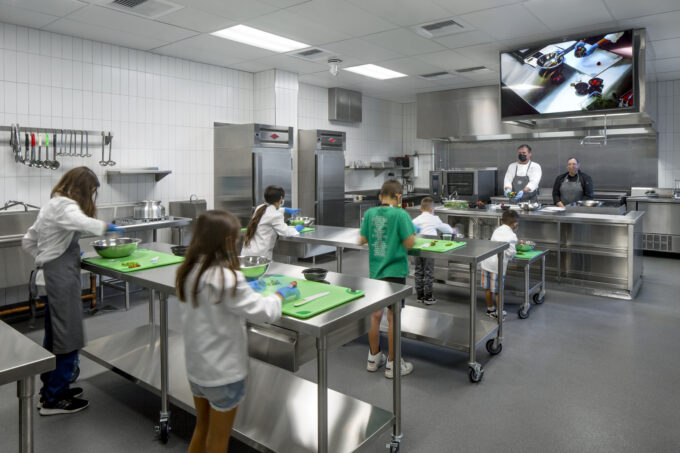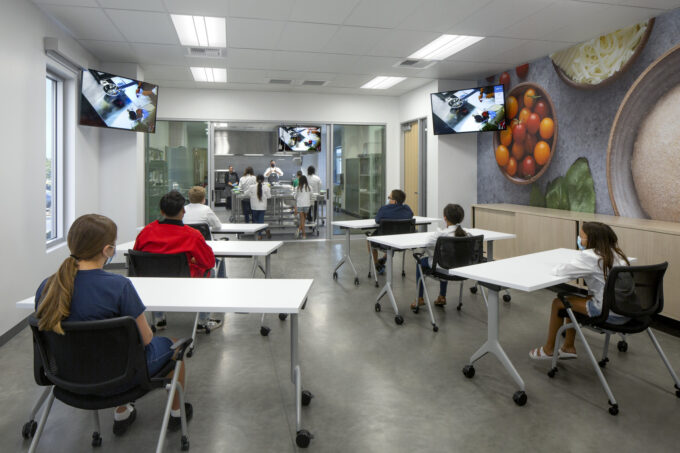This school year, California became the first state to implement a permanent Universal Meals Program statewide. Assembly Bill 130, signed into law by Governor Newsom last July, requires TK-12 public school districts and charter schools to provide two free meals (breakfast and lunch) to students requesting a meal for each school day regardless of their free or reduced-price meal eligibility.
The California State Legislature has allocated $650 million annually to provide additional state meal reimbursement to cover the cost of the Universal Meals Program. The 2021 State budget also included $150 million in one-time funding to support kitchen infrastructure and nutrition staff training to help implement the California Universal Meals Program. This state program builds on the foundations of federal programs: National School Lunch Program (NSLP), School Breakfast Program (SBP), and the Community Eligible Provision (CEP).
The 2022–23 state budget includes $596 million in the Proposition 98 General Fund to fund universal access to subsidized school meals. Further, the budget includes an additional $611.8 million ongoing Proposition 98 General Fund to augment the state’s meal reimbursement rate sufficient to maintain meal reimbursement rates beginning in 2022–23. The budget also funds an additional $600 million in the Kitchen Infrastructure Grant Program and $100 million for local educational agencies (LEAs) to implement best practices, including serving California-grown food. The CDE is currently working to implement these programs. It is anticipated that further information and application will be available in fall 2022.
California took this extraordinary step to meet the growing need across the state, a need that reflects a more significant crisis of poverty across the U.S. During the 2019-2020 school year, almost 60 percent of California public school students qualified for free or reduced-price school meals. (1) Twenty percent of Californians, approximately eight million people, are experiencing food insecurity (2) — defined as the lack of consistent access to food. Many advocates see this law as a significant step toward ending or reducing food insecurity.
School nutrition is key to several positive outcomes for students. Students are focused and successful in class after they’ve had a healthy breakfast, which leads to higher graduation rates and overall academic success. (3) After-school nutrition is just as vital; studies have shown that after-school meals encourage higher attendance and test scores. (4) Access to free or low-cost school meals encourages children to eat more fruits and vegetables, setting them up for healthy futures. (5) Schools are a vital resource for children struggling with food insecurity, and nutrition programs work hard to make food available to hungry students. These programs have never been more critical when families are still dealing with the effects of a global pandemic and rising inflation.
60 percent of California public school students qualified for free or reuced-price school meals in 2019-20.
Optimizing Nutrition at SCUSD’s Central Kitchen
Sacramento City Unified School District’s (SCUSD) Central Kitchen is emerging as a leader in finding funding, improving cost, and finding operational efficiencies. They are significantly upgrading the quality of the meals via purchasing strategy and relationships with local farms to provide students with their daily dose of fruits and vegetables.
Their newly built Central Kitchen, designed by HMC Architects, has scaled up to meet the increasing need among students and families, primarily through the pandemic, when they departed from the previous school meal structure to address the emergency. Recently we joined as another school district toured the facility, interested in the innovative aspects of the operation and the infrastructure. Director Diana Flores and Assistant Director Kelsey Nederveld showed us around the 50,000 SF of kitchen, warehouse, and open-plan office space, one of the region’s more extensive industrial culinary facilities.
They prepare 43,000 meals daily, distributed to 80 district sites via nine delivery routes serviced by a fleet of refrigerated trucks. Some 375 district nutrition staff execute this ambitious daily routine. As the 13th largest school district in California with 43,830 students, there is a real opportunity to leverage economies of scale. Diana and Kelsey discuss how the Central Kitchen doesn’t replace the on-site kitchens. “They work together as a system. We do primary meal prep here, and then meals are finished at school sites.”
They take us through their optimized purchasing approach. “Having this warehouse is a game-changer, allowing us to buy direct from food sources like Tyson Foods and General Mills, cutting out the middleman and saving on distribution markups. For shelf-stable items, this changes our thinking on how we purchase. For instance, when we purchase a truckload of Cheerios, we save 10 cents per unit, that is a $9,500 savings for every truckload purchased. We purchase four truckloads a year yielding a savings of $38,000 which is in turn used to enhance the quality and variety of our menus. We save on food so we can spend more on the food.”
Another example of how Central Kitchen is optimizing its operation, they have developed custom software that will track and manage all aspects of its process, from inventory to food expiration dates to distribution. “We are migrating the current version to a cloud-based platform, Flores adds, “this gives us the information we need to manage effectively.”

Farm to School to Student
The discussion of scale and logistics perhaps misses an exciting part of the Central Kitchen story: they are significantly upgrading the quality of the school meal. They are doing this in two main ways: by cooking on-site rather than buying pre-fab meal products and by sourcing from local farms and growers. Because of Sacramento’s proximity to the rich Central Valley farmland, this is natural. And because in recent years, Sacramento has established a reputation as a hub for the Farm-to-Fork movement.
Buying direct from local farms is smart financially and increases the quality of the meals. The Central Kitchen’s first farm partner was Miller Citrus Farm in Penryn, California, from whom they purchase the entire mandarin crop. “It’s good for the farmer, and it’s great for us,” Kelsey explains. She mentions other farms: Farmington Fresh in Stockton provides sliced apples packed in half-cup portions. “Serving whole apples leads to a lot of waste. Portions are the way to go.” By sending the district’s refrigerated trucks to pick up the apples, SCUSD saves $90,000 annually.
The Central Kitchen is working now on a unique “Forward Planting Contract” with a 55-acre farm in suburban Sacramento, Soil Born Farms. In this type of agreement, the kitchen purchases the crop before it’s planted, which allows for advanced planning on both sides and regularizes the transactions. “Currently, we buy 200 heads of lettuce a week, with plans to increase to a maximum of 800 heads a week,” Flores explains that lettuce handling is tricky due to the potential for contamination. The staff is trained on how to sanitize and pack lettuce in two to three-pound bags before it is sent to the school sites.
The California Department of Food and Agriculture has a grant program to encourage small farms to sell their fresh produce directly to schools. The governor doubled the grant budget in 2020. Flores mentions, “since not a lot of farms are aware of the program, there’s a lot of grant money out there.”
20 percent of Californias (8 million people) are experiencing food insecurity.

Facility Design for Nutrition
Stan Ng, an HMC project manager who helped design the Central Kitchen, is on the tour with us. He points out details of the design, including the demonstration kitchen and meeting spaces that allow for the hosting of events. Ng explains a vital element of the overall site planning, how the $70 million project maximized the use of three separate district properties: the existing transportation facility, an existing central warehouse, and a new adjacent property purchased for the project. HMC moved the transportation facility to the newly purchased property, which allowed us to fully renovate the 50,000 SF warehouse to house nutrition warehouse administration and support Central Kitchen bulk storage functions. There are efficiencies in having transportation and nutrition on adjacent sites.
Nutritious food is an integral part of performance and wellness. Diana shared perhaps one of the most essential parts of the nutrition program: “they (SCUSD students) come for the food.” This shows a strong need for free meal programs in the district. Knowing how vital food security is to student success, SCUSD’s Central Kitchen stands ready to support each of its 40,000 K-12 students. Flores adds that the contemporary open-plan office space encourages staff collaboration and helps everyone stay enthusiastic about the Central Kitchen mission. It is a beautiful facility at the center of a well-organized network of school site kitchens. Considering this larger picture, it’s easy to see why other districts are interested in modeling after the Central Kitchen.
Buying direct from local farms is smart financially and increases the quality of the meals.
An Upside During Challenging Times
The Central Kitchen has only been operational for about a year, not counting the unique circumstances during the pandemic. So much of their ambitious plan has yet to be fully launched or realized. Nonetheless, this is an optimistic story in a harsh landscape of hungry students and families. You can’t help but root for Diana, Kelsey, and their team as they continue to find new and better ways to serve Sac City students. They are dedicated, intelligent managers who think outside the traditional school nutrition box. Beyond the daily operational logistics, they remain focused on the bottom line of school nutrition: that food is a key factor in kids showing up, engaging in school life, and having success.
Further reading:
1. School Meals for All, a coalition made up of more than 200 organizations
2. CA Association of Food Banks
3. No Kid Hungry and School Nutrition Association
4. No Kid Hungry
5. Food Research and Action Center

